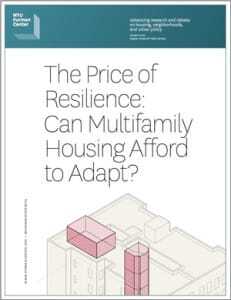For all the havoc that Superstorm Sandy wreaked on single-family homes, the vast majority of residential units in flood zones were in multifamily buildings. A new report from New York University’s Furman Center underscores the challenges of retrofitting New York City’s multifamily housing stock—ranging from walkups with a half-dozen units to large towers with more than 100 units—against the threat of rising sea levels and extreme weather events.
The report—The Price of Resilience: Can Multifamily Housing Afford to Adapt?—describes design solutions and offers policy recommendations for municipal officials and for the Federal Emergency Management Agency (FEMA) aimed at removing barriers to achieving long-term resilience in the city’s limited stock of affordable housing, most of which is multifamily. It was conducted in partnership with Enterprise Community Partners and the New York chapter of the American Institute of Architects.
Related: Register for ULI Fall Meeting
“Storm-proofing a dense, older city like New York poses unique challenges,” says Jessica Yager, policy director at the Furman Center and coauthorof the study. “Over 90 percent of the multifamily buildings in areas vulnerable to flooding were built prior to 1983, when flood-resistance standards were added into the building code.” Yager says the city needs not only to tighten standards for new construction but also to retrofit older buildings.
FEMA’s latest flood insurance maps place nearly 5,000 multifamily buildings—holding 170,000 units—in the city’s 100-year floodplain. Many of these buildings, Yager says, face either expensive and destructive retrofits or continuing vulnerability and rapidly rising flood insurance premiums. Both alternatives, she adds, could make units unaffordable.
The situation, adds Yager, “also poses a real public policy problem for . . . a city that is spending a lot of resources on trying to increase affordable housing,” now in extremely short supply. New York City’s goal is for public housing to grow to 200,000 units in ten years.
New York’s affordable housing is commonly found in areas prone to flooding. According to the report, 72 percent of residential units in the 100-year and 500-years floodplains are in multifamily buildings, and the majority of those units are either rent stabilized, subsidized, or public housing—that is, affordable.
Tearing down all units below the predicted flood level, for example, “could result in the loss of thousands of indispensable housing units,” the report observes. “Even if units are not lost, property owners may pass on the costs of retrofitting buildings to residents through a rent increase, reducing the supply of affordable units in New York City’s coastal areas.”
The report warns that for buildings unable to raise funds for improvements by raising rents, “the financial burden of making costly retrofits might be overwhelming, leading to the conversion of these buildings to market rate [when permitted], unsustainable operating budgets, or a large number of buildings left unprepared for future storms.”
On the other hand, the cost of not retrofitting could be punishing as well, the report finds. Without retrofitting, it notes, “Building owners may face skyrocketing flood insurance premiums.”
“If we were to lose [affordable] units in the flood zone because of these problems,” Yager says, “that would be a real blow.”
The report calls for various reforms by New York City and FEMA.
First, since FEMA guidelines focus on smaller residences, it urges the agency to provide more guidance on how to retrofit multifamily buildings. It also asks FEMA to consider reducing insurance premiums for building owners who have made partial improvements in resilience.
Second, it recommends that the city extend the zoning changes it made after Sandy in its 100-year floodplain to cover buildings in the 500-year floodplain. This would make it easier for owners to invest in measures that make properties more flood resistant. For example, the zoning could make it possible for mechanical and electrical systems normally located in the basement to be moved to a yard, as owners in the 100-year floodplain can more easily do now.
Third, it asks the city to ensure that its various rehabilitation subsidy programs for affordable housing can be readily funded. Yager notes that the city already has the Build It Back program for Sandy recovery, but calls it “limited in scope and dollars.”
The report also advises the city to require that buildings it assists in these flood zones prepare for disasters and have long-term capital plans that include resilience.
“The reason why the report is so important is that it flags a growing issue,” says ULI senior housing fellow John McIlwain. He advises every major city to look at the report, but sees financing issues as standing in the way of its recommendations. With housing costs rising, tenants and building owners strapped financially, and government at all levels fiscally limited, he says, “there really isn’t the money to do what’s necessary to protect the buildings even within the 100-year zone.”
Instead, he advises that cities come up with carefully thought-out strategies and plans to protect neighborhoods and residents in the event of a major storm. These plans need to be neighborhood- and building-specific, he says, and in the case of some residents, like the infirm, resident-specific.
NYU Furman Center’s Retrofit Solutions Workshop from Furman Center on Vimeo.





